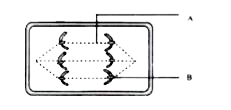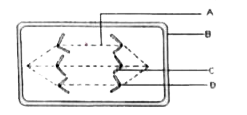Two daughter cells formed after mitosis are
Non-identical to each other
Identical to each other
Non-identical to parents
Irregular is size
The correct Answer is:B
To answer the question "Two daughter cells formed after mitosis are," we can follow these steps:
1. Understand Mitosis: Mitosis is a type of cell division that results in two daughter cells. It is crucial to know that mitosis is characterized by the equal distribution of genetic material.
2. Identify the Characteristics of Daughter Cells: After mitosis, the daughter cells are formed from a parent cell. The genetic material is replicated and divided equally, ensuring that each daughter cell receives an identical set of chromosomes.
3. Ploidy Level: The ploidy level refers to the number of sets of chromosomes in a cell. In mitosis, the ploidy level of the daughter cells is the same as that of the parent cell. For instance, if the parent cell is diploid (2n), both daughter cells will also be diploid (2n).
4. Evaluate the Options:
- Option 1: Non-identical to each other - This is incorrect because the daughter cells are identical.
- Option 2: Identical to each other - This is correct as both daughter cells have the same genetic material.
- Option 3: Non-identical to parents - This is incorrect because the daughter cells are identical to the parent cell.
- Option 4: Irregular in size - This is incorrect as the daughter cells are typically similar in size.
5. Conclusion: The correct answer is that the two daughter cells formed after mitosis are identical to each other.
Final Answer:
The two daughter cells formed after mitosis are identical to each other.
---
- Option 1: Non-identical to each other - This is incorrect because the daughter cells are identical.
- Option 2: Identical to each other - This is correct as both daughter cells have the same genetic material.
- Option 3: Non-identical to parents - This is incorrect because the daughter cells are identical to the parent cell.
- Option 4: Irregular in size - This is incorrect as the daughter cells are typically similar in size.
The two daughter cells formed after mitosis are identical to each other.
Topper's Solved these Questions
- CELL CYCLE AND CELL DIVISION BOOK - AAKASH INSTITUTE ENGLISHCHAPTER - CELL CYCLE AND CELL DIVISION EXERCISE - Section - B
35 Videos
- CELL CYCLE AND CELL DIVISION BOOK - AAKASH INSTITUTE ENGLISHCHAPTER - CELL CYCLE AND CELL DIVISION EXERCISE - SECTION - C ( Previous year Questions )
53 Videos
- CELL CYCLE AND CELL DIVISION BOOK - AAKASH INSTITUTE ENGLISHCHAPTER - CELL CYCLE AND CELL DIVISION EXERCISE - EXERCISE
20 Videos
- BREATHING AND EXCHANGE OF GASES BOOK - AAKASH INSTITUTE ENGLISHCHAPTER - BREATHING AND EXCHANGE OF GASES EXERCISE - ASSIGNMENT SECTION - D
11 Videos
- CELL:THE UNIT OF LIFE BOOK - AAKASH INSTITUTE ENGLISHCHAPTER - CELL:THE UNIT OF LIFE EXERCISE - Try Yourself
26 Videos
Similar Questions
Four daughter cells formed after meiosis are
View SolutionFour daughter cells formed after meiosis are
(a) Genetically similar
(b) Genetically different
(c) Anucleate
(d) Mutinucleate
View SolutionIf a diploid daughter cell formed after mitosis has 16 chromosomes and 2C content of DNA, what would have been the chromosome number and DNA content in its parent cell?
View SolutionDaughter cells formed after mitosis resemble to their mother cell but daughter cells formed after meiosis different from mother cells:
View SolutionThe number of daughter cells formed at the end of meiosis from a cell are.
View SolutionHow many daughter cells are formed at the end of mitosis and at the end of meiosis?
View SolutionThe diagram given below represents a certain stage of mitosis :

How many daughter cells are formed from this type of cell division?
View Solution$ Karyokinesis is followed by cytokinesis.
! Two daughter nuclei are formed after telophase.
View SolutionIf the number of bivalents are 8 in metaphase - I, what shall be the number of chromosomes in daughter cells after meiosis -I and meiosis -II respectively:-
View SolutionThe diagram given below represents a stage in cell division. Study the same and answer the questions that follows:

How many daughter cells are formed from this type of cell division ?
View Solution
